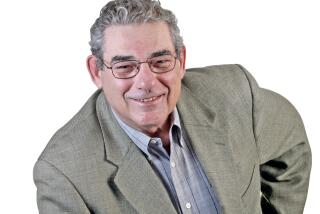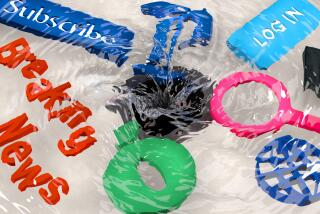In S.F., Battle of the Old Media
- Share via
SAN FRANCISCO — The San Francisco Examiner, or rather its new incarnation, sits upstairs from a seedy theater-turned-rock club in the Tenderloin. The lobby is the size of a walk-in closet. Taped-up signs near the one good elevator offer directions to the relocated newsroom. Wind wafts down the rickety stairwell, which smells unmistakably--and intensely--of cannabis.
On the mezzanine level, a fellow tenant turns out to be running a medicinal marijuana dispensary. A homeless man in a wheelchair whips the newspaper out of his bush jacket. It’s as flimsy as junk mail. “What’re they doin’ up there, anyway?” he slurs. “They used to be a pretty good paper. Now--” The man suddenly spots a goateed young attendant and decides not to wait for an answer. “Hey, buddy! Gimme $20 of that high-grade Mexican!”
For the record:
12:00 a.m. Feb. 7, 2001 For the Record
Los Angeles Times Wednesday February 7, 2001 Home Edition Southern California Living Part E Page 3 View Desk 1 inches; 26 words Type of Material: Correction
Educator’s title--Cynthia Gorney was misidentified in a story Monday about San Francisco newspapers. Her title is associate dean of the UC Berkeley Graduate School of Journalism.
Well, the news is just one among many diversions in this storied city. Still, the question of what, exactly, they’re doing up at the Examiner--and across town at the dominant Chronicle, for that matter--has become a minor civic pastime here. In the nearly three months since San Francisco’s two best-known rival dailies formally launched themselves separately from the joint operating agreement that had bound them since the mid-1960s, their paths have generated headlines, if not always readers:
“Glitch Delays Debut of New S.F. Examiner.” “Morning Sickness: Where’s the ‘World-Class’ Chron?” “Examiner Continues Rocky Start, Replaces Executive Editor After Three Weeks.”
“Fun Couple Freak Out,” the Examiner snickered this month in a column that posed the burning question: Did the Chronicle’s new executive editor, who is married to Sharon Stone, demote a columnist for having written snotty things about the actress? (No, the executive, Phil Bronstein, told a media Web site. And it was a lateral move, from news to sports, where he has spent much of his career, says the columnist, Scott Ostler. Although Ostler admits that Stone did upbraid him once when she ran into him at the ballet.)
The Examiner is certainly trying, resurrecting both the late Herb Caen’s old Chronicle logo and Hunter S. Thompson. On the other hand, there has also been a now-famous epidemic of computer-glitch-based typos, which continue to be enumerated in the city’s alternative weeklies. Entries have included the day the paper misspelled the names of its own editors; the day it misspelled “Wednesday” on the front page; and the day the paper’s masthead--which is supposed to read, “Keeping San Francisco a two-newspaper town”--misspelled “San Francisco” so that it sounded like “San Frank Sicko” when read aloud.
“It’s certainly been interesting,” laughs Susan Rasky, senior lecturer at UC Berkeley’s Graduate School of Journalism. So far, though, she adds, it isn’t yet clear whether the city’s evolving newspaper choices will finally connect with the “noisy, funny, diverse, parochial, extremely sophisticated” city that has carped about the quality of its Old Media for so long.
Nor is it clear, in an era of hourly updates via broad-band transmission and targeted e-mail newsletters, that even the best efforts of the city’s ink-and-paper crowd will be sufficient. News is, as noted, just one among many diversions. Even among newspapers, “San Francisco is an extremely competitive market,” notes media industry analyst John Morton of Morton Research Inc.
The new merged Chronicle and the new Hearst-subsidized Examiner face competition in and out of San Francisco, from alternative weeklies, suburban dailies and national papers (the New York Times, at last count, was selling more than 36,000 papers in the San Francisco Bay Area each Sunday). The San Jose Mercury News recently launched a San Francisco edition. Rumors are rampant that Denver-based newspaper magnate Dean Singleton, owner of the group that publishes the Oakland Tribune, other East Bay papers and papers around the country, plans to make a foray into the city.
From this fray, separate questions have emerged for the two reconstituted San Francisco dailies since Hearst Corp. bought the Chronicle. The deal shuffled the papers’ staffs and assets, folding the Examiner’s staff into the Chronicle while transferring the Examiner’s name and remaining assets, along with a $66-million subsidy, to San Francisco’s politically connected Fang family, which owns small newspapers and real estate.
For the Chronicle, the question has been: Will it deliver a newspaper, at last, that is as worldly and successful as its city?
For the Examiner, it’s: Will it deliver a real newspaper at all?
Or did its new owners just take on the Hearst’s flagship for all the free money they’d get, with the legal stipulation that it be spent on the Examiner?
The Chronicle’s answer has been cautiously upbeat. Interim circulation figures to be filed this month indicate that the paper has hung onto most of the total 552,828 daily circulation of the two papers before the merger. Chronicle circulation now stands at about 530,000 daily and 550,000 Sunday, according to Chronicle Publisher and Chief Executive John Oppedahl.
Oppedahl, 56, says his first job is to integrate the staffs of what once were two papers, a shared Web site and a business operation. Beyond that, he wants to beef up the Sunday paper and Sunday circulation, improving the ad-generating business, travel and sports pages. Because the Chronicle absorbed in near-entirety the staff of the old Examiner, it now has some 570 reporters, editors and other editorial employees at its disposal--the second-largest newsroom on the West Coast, next to that of the Los Angeles Times.
Such bounty, however, is expensive--and complex to address, since Hearst Corp. is known for its bottom-line focus and the Chronicle is unionized.
The paper, which occupies the same building that once housed both the Chronicle and the Examiner, has at least two of everything a newspaper could want, from libel lawyers to bass-fishing experts to I-am-woman-hear-me-roar pundits on the op-ed page. Bylines are stacked three and four to a story, like partners in law firms. There are seven sports columnists now, counting Ostler. The Examiner and Chronicle people--hard-core rivals before the merger--still sit, for the most part, in their own former newsrooms, monitoring every personnel shift for signs of favoritism by the executive editor (an Examiner guy) or the managing editor (a Chronicle guy).
Delicate media egos are said to have been traumatized.
Among readers, reviews are mixed. Kevin McNamee, a cabdriver, canceled the paper, grousing, “They kept messing up the Daily Three numbers in the California Lottery.”
“It’s just conservative and boring, the way everything in San Francisco has gotten conservative and boring,” grumbles Bay Area native Cintra Wilson, whose freelance advice column, “Cintra Wilson Feels Your Pain,” was dropped by what she calls “the New Improved Uberchronicle.” Yes, it’s sour grapes, she says, and, yes, she has moved to New York, but she still sees the paper when she visits her family.
“This is how it’s been, ever since the flood of dot-com money came in and all the sort of artistic and interesting and thoughtful and filthy bohemian mom-and-poppy stuff went out the window,” she sighs.
But Cynthia Gorney, assistant dean of the Graduate School of Journalism at UC Berkeley, says the Chronicle is improving. “It’s not perfect yet, but within about three weeks of the merger, I started hearing people say, ‘Hey, more foreign coverage,’ or ‘Hey, that was a good story,’ or ‘Hey, that paper’s lookin’ good.’ ”
Examiner Circulation, Advertising Declining
The new Examiner’s progress has been slower, but more entertaining, and not just because the paper that, under William Randolph Hearst, shrieked about the “yellow peril” is now owned by the scions of Chinese immigrants.
Ted Fang, 37, the new owner and publisher, says the Examiner’s paid circulation, which was about 114,000 when he took over the name and remaining assets, has dropped to perhaps 90,000, of which fewer than 30,000 are home delivered. (Those figures are unaudited, however, and could not be verified.) Macy’s--the bulwark of newspaper advertising in this city--had bought one Examiner ad per week in December but stopped after Christmas, according to a Macy’s West spokeswoman. Good Guys, another big ad buyer, says it’s not buying ads in the Examiner, either. On most days, the paper’s biggest advertiser appears to be itself.
Fang has, theoretically, cut his cost of doing business by moving into two floors of the venerable Warfield Theater building; what rent he pays goes to the building’s owner, his brother, James. The subsidy, paid by Hearst Corp. to satisfy federal antitrust concerns, has underwritten the paper’s staff of about 50 mostly junior reporters. However, it runs out after three years, and critics worry that the Fangs will then fold the Examiner into their other big local holding--a chain of free neighborhood papers in which the eye-patched columnist Warren Hinckle writes front-page excoriations of anyone on the wrong side of the Fangs’ friend, Mayor Willie Brown. Hinckle, who is now an associate editor at the Examiner, is a fixture of San Francisco journalism, having written for both the Chronicle and Examiner over the years.
Adding to the buzz, the new Examiner’s initial management has turned over almost entirely. Within a month of the Examiner’s relaunch, both the executive editor, Martha Steffens, 47, and her managing editor, Robert M. Porterfield, 55, had been removed. Steffens, who oversaw the first day of publication--in which the paper came out hours past deadline--had a three-year contract and has stayed on as a consultant. (“I feel proud just to have gotten the darned thing up and running,” she says now, adding that there are “no hard feelings” between her and the Fangs.)
Porterfield was fired after a shouting match with Steffens’ replacement, David Burgin, 61. The argument was about Warren Hinckle’s column, Burgin says. Porterfield insisted that it run on the op-ed page and not the news pages; Burgin says he was unwilling to make that commitment so early in his new job. As it turned out, Hinckle’s work hasn’t been in the paper at all since Burgin’s arrival. Nonetheless, Porterfield--reached at his home last week--called the Examiner “a start-up that turned into a mess” and referred inquiries about the experience to his lawyer.
Burgin, who edited the Examiner briefly during the 1980s, says he was recruited for the Fangs by a North Beach bar owner who “called me up and said, ‘Hey, I gave your name to Hinckle.’ ” Porterfield’s firing, he confirmed, was “an ugly scene.”
Burgin and Fang urge patience with the new paper, however. Burgin says he’s reconfiguring the sports section to appeal more to gamblers. (He says he corralled a reporter the other day and informed him that, henceforth, his byline would be “Lefty” and his specialty would be fantasy teams and sports betting. “But I’m right-handed,” protested the reporter. “Exactly,” said Burgin.) He notes that the paper has already gotten some attention by “borrowing” Herb Caen’s old Chronicle logo--a cartoon of the San Francisco skyline, now slightly tweaked--over the byline of a new Examiner columnist.
Plus, the aging gonzo-journalist Hunter S. Thompson has returned to his old paper as part of an “exclusive deal . . . we hope” to reprint his online column weekly in the Examiner. (His first dispatch detailed a failed attempt to get Rolling Stone Keith Richards to accompany him to the Super Bowl.)
“The Examiner is like a newborn baby. It’s still developing its personality,” Fang says. “We won’t reflect any one person in this town, be it the mayor or a socialite or even”--here he chuckles impishly--”a movie star.”
Like the smell of dope on the mezzanine of a daily newspaper, the Examiner will surprise people--and linger, he promises. “Other publishers come and go,” he vows. “Ted Fang stays around.”


